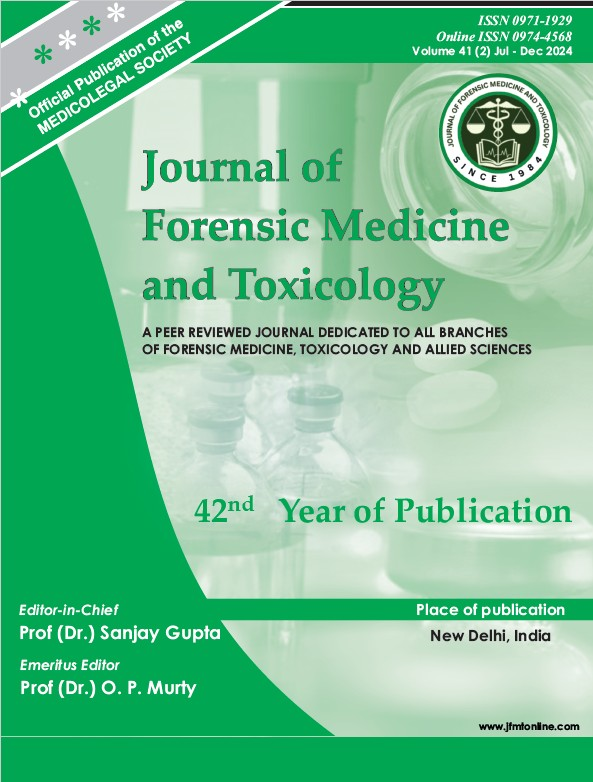ELECTRICAL EXCITATION OF SKELETAL MUSCLES FOR THE ESTIMATION OF TIME SINCE DEATH USING SQUARE WAVE GENERATOR
DOI:
https://doi.org/10.48165/jfmt.2024.41.2.12Keywords:
electrical excitability, post-mortem, skeletal muscles, time since deathAbstract
Post-mortem electrical excitation of skeletal muscles was measured using needle electrodes inserted into human muscles. The electrical excitability of the orbicularis oculi and orbicularis oris muscles was evaluated in 19 cadavers using a subjective grading system developed by Krause and Popwassilew. Electrical stimulation was provided by a square wave generator producing constant-current rectangular impulses of 30 mA, 10 ms duration, and a repetition rate of 50 per second. It was observed that there was a significant negative correlation between the degree of muscle contraction and the post mortem interval. Rapid loss of muscle excitation was observed in cases where muscles were grossly damaged. Prolonged excitation was seen in cases where hematoma or emphysema of the eye was present.
Downloads
References
Suhani MN, Shahrom AW, Zarida H. Electrical excitation of skeletal muscle for the estimation of time since death in the early postmortem period. Journal of Forensic Medicine. 2006 Jul 1;23(2):1–6.
Madea B, Henssge C. Electrical excitability of skeletal muscle postmortem in casework. Forensic Science International. 1990 Oct;47(3):207–27.
Poposka V, Janeska B, Gutevska A, Duma A. Estimation of time since death through electric and chemical excitability of muscles. PubMed. 2011 Jan 1;32(1):211–8.
Saukko PJ, Knight B. Knight’s forensic pathology. Boca Raton: CRC Press; 2016.
Tidy CM. Changes in the muscle and in the general condition of the body after death. Legal Medicine. Part 1, London: Smith-Elder; 1882. P.46
Jones M, James W, Barasi S, Nokes L. Postmortem electrical excitability of skeletal muscle: preliminary investigation of an animal model. Forensic Sci Int; 1995; 76(2): 91-96
Krompecher T, Bergerioux C. Experimental evaluation of rigor mortis. VII. Effect of ante- and post-mortem electrocution on the evolution of rigor mortis. Forensic Sci Int. 1988 Jul-Aug;38(1-2):27-35.
Krompecher T. Objective measurements of rigor mortis. In: Henssge C, Knight B, Krompecher T, Madea B, Nokes L. The estimation of the time since death in the early postmortem period, London: Edward Arnold;1995. P. 156-165
Madea, B. Postmortem electrical excitability of skeletal muscle in casework. In: Henssge C, Knight B, Krompecher, T, Madea, B, Nokes L. The estimation of the time since death in the early postmortem period. London: Edward Arnold; 1995a. P. 172-217.
Feng TP. The effect of length on the resting metabolism of muscle. The Journal of Physiology. 1932 Apr 26;74(4):441–54.




